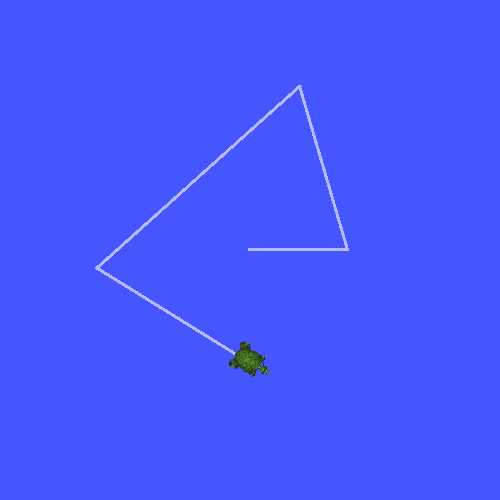编写广播器(Python) [6028]
**目标:**学习如何将机器人的状态广播到tf2。 [5998]
教程级别: 中级 [16770]
时间: 15分钟 [3507]
内容 [16422]
背景 [16410]
在接下来的两个教程中,我们将编写代码来重现 Introduction to tf2 教程中的演示。之后,后续教程将重点介绍如何使用更高级的tf2功能扩展演示,包括在转换查找中使用超时和时间旅行。 [5999]
先决条件 [16411]
本教程假设你具有ROS 2的基本知识,并且已经完成了:Introduction to tf2 tutorial。在之前的教程中,你学会了如何创建工作空间和软件包。你还创建了``learning_tf2_py``包,我们将从这里继续工作。 [6029]
任务 [16427]
1. 编写广播器节点 [6001]
首先,让我们创建源代码文件。进入之前创建的``learning_tf2_py``软件包。在``src/learning_tf2_py/learning_tf2_py``目录中,通过输入以下命令下载示例广播器代码: [6030]
wget https://raw.githubusercontent.com/ros/geometry_tutorials/ros2/turtle_tf2_py/turtle_tf2_py/turtle_tf2_broadcaster.py
wget https://raw.githubusercontent.com/ros/geometry_tutorials/ros2/turtle_tf2_py/turtle_tf2_py/turtle_tf2_broadcaster.py
在 Windows 命令行提示符中: [4843]
curl -sk https://raw.githubusercontent.com/ros/geometry_tutorials/ros2/turtle_tf2_py/turtle_tf2_py/turtle_tf2_broadcaster.py -o turtle_tf2_broadcaster.py
或者在powershell中执行: [4844]
curl https://raw.githubusercontent.com/ros/geometry_tutorials/ros2/turtle_tf2_py/turtle_tf2_py/turtle_tf2_broadcaster.py -o turtle_tf2_broadcaster.py
使用您偏爱的文本编辑器打开该文件。 [4933]
import math
from geometry_msgs.msg import TransformStamped
import numpy as np
import rclpy
from rclpy.node import Node
from tf2_ros import TransformBroadcaster
from turtlesim.msg import Pose
def quaternion_from_euler(ai, aj, ak):
ai /= 2.0
aj /= 2.0
ak /= 2.0
ci = math.cos(ai)
si = math.sin(ai)
cj = math.cos(aj)
sj = math.sin(aj)
ck = math.cos(ak)
sk = math.sin(ak)
cc = ci*ck
cs = ci*sk
sc = si*ck
ss = si*sk
q = np.empty((4, ))
q[0] = cj*sc - sj*cs
q[1] = cj*ss + sj*cc
q[2] = cj*cs - sj*sc
q[3] = cj*cc + sj*ss
return q
class FramePublisher(Node):
def __init__(self):
super().__init__('turtle_tf2_frame_publisher')
# Declare and acquire `turtlename` parameter
self.turtlename = self.declare_parameter(
'turtlename', 'turtle').get_parameter_value().string_value
# Initialize the transform broadcaster
self.tf_broadcaster = TransformBroadcaster(self)
# Subscribe to a turtle{1}{2}/pose topic and call handle_turtle_pose
# callback function on each message
self.subscription = self.create_subscription(
Pose,
f'/{self.turtlename}/pose',
self.handle_turtle_pose,
1)
self.subscription # prevent unused variable warning
def handle_turtle_pose(self, msg):
t = TransformStamped()
# Read message content and assign it to
# corresponding tf variables
t.header.stamp = self.get_clock().now().to_msg()
t.header.frame_id = 'world'
t.child_frame_id = self.turtlename
# Turtle only exists in 2D, thus we get x and y translation
# coordinates from the message and set the z coordinate to 0
t.transform.translation.x = msg.x
t.transform.translation.y = msg.y
t.transform.translation.z = 0.0
# For the same reason, turtle can only rotate around one axis
# and this why we set rotation in x and y to 0 and obtain
# rotation in z axis from the message
q = quaternion_from_euler(0, 0, msg.theta)
t.transform.rotation.x = q[0]
t.transform.rotation.y = q[1]
t.transform.rotation.z = q[2]
t.transform.rotation.w = q[3]
# Send the transformation
self.tf_broadcaster.sendTransform(t)
def main():
rclpy.init()
node = FramePublisher()
try:
rclpy.spin(node)
except KeyboardInterrupt:
pass
rclpy.shutdown()
1.1 检查代码 [16633]
现在,让我们来看一下与将海龟位姿发布到 tf2 相关的代码。首先,我们定义并获取一个参数 turtlename,它指定了一个海龟的名称,例如 turtle1 或者 turtle2。 [6003]
self.turtlename = self.declare_parameter(
'turtlename', 'turtle').get_parameter_value().string_value
接下来,节点订阅了 turtleX/pose 主题,并在每个传入的消息上运行函数 handle_turtle_pose。 [6004]
self .subscription = self.create_subscription(
Pose,
f'/{self.turtlename}/pose',
self.handle_turtle_pose,
1)
现在,我们创建一个 TransformStamped 对象,并为其添加适当的元数据。 [6005]
我们需要给要发布的变换添加时间戳,我们将使用``self.get_clock().now()``调用来将其标记为当前时间。这将返回``Node``使用的当前时间。 [6031]
然后,我们需要设置正在创建的链接的父帧的名称,本例中为
world。 [6007]最后,我们需要设置链接创建的子节点的名称,这里的子节点名称就是乌龟自身的名称。 [6008]
处理乌龟姿态消息的处理函数会广播该乌龟的平移和旋转,并将其发布为从帧``world``到帧``turtleX``的变换。 [6009]
t = TransformStamped()
# Read message content and assign it to
# corresponding tf variables
t.header.stamp = self.get_clock().now().to_msg()
t.header.frame_id = 'world'
t.child_frame_id = self.turtlename
在这里,我们将3D乌龟姿态的信息复制到3D变换中。 [6010]
# Turtle only exists in 2D, thus we get x and y translation
# coordinates from the message and set the z coordinate to 0
t.transform.translation.x = msg.x
t.transform.translation.y = msg.y
t.transform.translation.z = 0.0
# For the same reason, turtle can only rotate around one axis
# and this why we set rotation in x and y to 0 and obtain
# rotation in z axis from the message
q = quaternion_from_euler(0, 0, msg.theta)
t.transform.rotation.x = q[0]
t.transform.rotation.y = q[1]
t.transform.rotation.z = q[2]
t.transform.rotation.w = q[3]
最后,我们将构建的变换传递给``TransformBroadcaster``的``sendTransform``方法,它会负责广播。 [6011]
# Send the transformation
self.tf_broadcaster.sendTransform(t)
2 编写启动文件 [5397]
现在为此演示创建一个启动文件。使用文本编辑器,在``launch``文件夹中创建一个名为``turtle_tf2_demo.launch.py``的新文件,并添加以下内容: [6013]
from launch import LaunchDescription
from launch_ros.actions import Node
def generate_launch_description():
return LaunchDescription([
Node(
package='turtlesim',
executable='turtlesim_node',
name='sim'
),
Node(
package='learning_tf2_py',
executable='turtle_tf2_broadcaster',
name='broadcaster1',
parameters=[
{'turtlename': 'turtle1'}
]
),
])
2.1 检查代码 [16436]
首先我们从 launch 和 launch_ros 包中导入所需的模块。需要注意的是,launch 是一个通用的启动框架(不特定于ROS 2),而 launch_ros 则有ROS 2特定的功能,例如在这里我们导入的节点。 [6014]
from launch import LaunchDescription
from launch_ros.actions import Node
现在我们运行节点,启动turtlesim仿真,并使用我们的 turtle_tf2_broadcaster 节点将 turtle1 状态广播到tf2。 [6015]
Node(
package='turtlesim',
executable='turtlesim_node',
name='sim'
),
Node(
package='learning_tf2_py',
executable='turtle_tf2_broadcaster',
name='broadcaster1',
parameters=[
{'turtlename': 'turtle1'}
]
),
2.2 添加依赖项 [4853]
返回到``src/learning_tf2_py``目录的上一级,该目录中包含``setup.py``、``setup.cfg``和``package.xml``文件。 [6033]
使用文本编辑器打开 package.xml。根据你的启动文件的导入语句,添加以下依赖项: [6016]
<exec_depend>launch</exec_depend>
<exec_depend>launch_ros</exec_depend>
当执行其代码时,这将声明额外所需的 launch 和 launch_ros 依赖项。 [6017]
确保保存文件. [4859]
3 构建 [6020]
在你的工作空间的根目录中运行 rosdep,以检查缺少的依赖项。 [5738]
rosdep install -i --from-path src --rosdistro humble -y
rosdep 只能在 Linux 上运行,所以你需要自己安装 geometry_msgs 和 turtlesim 依赖项。 [5739]
rosdep 只能在 Linux 上运行,所以你需要自己安装 geometry_msgs 和 turtlesim 依赖项。 [5739]
仍然在工作空间的根目录中,构建您的软件包: [5770]
colcon build --packages-select learning_tf2_py
colcon build --packages-select learning_tf2_py
colcon build --merge-install --packages-select learning_tf2_py
打开一个新终端,进入你的工作空间的根目录,并源化设置文件: [5741]
. install/setup.bash
. install/setup.bash
# CMD
call install\setup.bat
# Powershell
.\install\setup.ps1
4 运行 [6021]
现在运行启动文件,启动turtlesim仿真节点和``turtle_tf2_broadcaster``节点: [6022]
ros2 launch learning_tf2_py turtle_tf2_demo.launch.py
在第二个终端窗口中输入以下命令: [5819]
ros2 run turtlesim turtle_teleop_key
你会看到turtlesim仿真已经启动,并且有一只你可以控制的乌龟。 [6023]

现在,使用``tf2_echo``工具检查乌龟的姿态是否真的被广播到tf2: [6024]
ros2 run tf2_ros tf2_echo world turtle1
这应该会显示第一只乌龟的姿态。使用箭头键驱动乌龟(确保你的``turtle_teleop_key``终端窗口处于活动状态,而不是仿真器窗口)。在控制台输出中,你会看到类似于以下内容: [6025]
At time 1625137663.912474878
- Translation: [5.276, 7.930, 0.000]
- Rotation: in Quaternion [0.000, 0.000, 0.934, -0.357]
At time 1625137664.950813527
- Translation: [3.750, 6.563, 0.000]
- Rotation: in Quaternion [0.000, 0.000, 0.934, -0.357]
At time 1625137665.906280726
- Translation: [2.320, 5.282, 0.000]
- Rotation: in Quaternion [0.000, 0.000, 0.934, -0.357]
At time 1625137666.850775673
- Translation: [2.153, 5.133, 0.000]
- Rotation: in Quaternion [0.000, 0.000, -0.365, 0.931]
如果你对``world``和``turtle2``之间的变换运行``tf2_echo``命令,你将不会看到任何变换,因为第二只乌龟尚未出现。然而,一旦我们在下一个教程中添加第二只乌龟,``turtle2``的位姿将会被广播到tf2。 [6026]
总结 [16454]
在本教程中,您学习了如何将机器人的姿态(乌龟的位置和方向)广播到tf2,以及如何使用``tf2_echo``工具。要实际使用广播到tf2的变换,请继续下一个有关创建:doc:tf2监听器 <./Writing-A-Tf2-Listener-Py>`的教程。 `[6037]